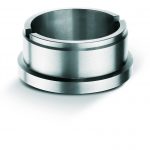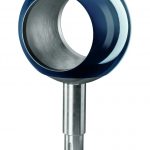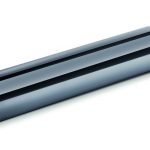Wear parts are the weak spots in valve technology. Face seals and seat rings, for example, have to resist extreme loads in daily use, which particularly affect the surface structure. Components made of resilient tungsten carbide may help extend the service life. Carbide-based surface coatings also achieve good results as a way to improve wear resistance.
Varying temperatures, pressure, vibration and aggressive media, often containing abrasive solid particles: the range of dynamic wear forces in pump casings is striking. This situation is exacerbated when two different components collide in the pumping process. Every collision poses an increasing risk that the surfaces concerned will be permanently damaged by abrasion and erosion. In addition, leakage problems may occur at the seal gap. There is a lubricating film which is vital for the sealing functions between the two face seals, one of which is linked to the pump shaft and the other to the casing.
As long as only a few barely visible drops of the medium being pumped escape and vaporise immediately afterwards, everything is fine. Things get critical, however, as soon as the pump visibly leaks liquid. This is considered to be a first warning sign of wear – or possibly of a defect which has already developed. The progress of wear is also dependent on the type of medium. The higher the proportion of contaminants due to abrasive materials like quartz, sand or salt, the faster the wear on the face seals will advance. The abrasive particles make their way between the sliding surfaces, where they settle and cause the seal to become porous.
All about the right material
Considering the different wear attacks in the pumping process, there is a high risk that increased operating time could lead sooner or later to a failure of vulnerable components, so that the system breaks down unexpectedly. Effective resistance to these detrimental influences is an urgent necessity. The right choice of material is one of the keys to success. The aim is to appreciably extend the service life of wear parts in the pump casing even under difficult conditions. The requirements for the material are very high, however, as shown by the following list. The desired features include:
- Resistance to erosion, abrasion and corrosion
- Chemical resistance
- Dimensional stability
- Resilience to fluctuating temperature, pressure, and shocks
- Compatibility with other materials
- No susceptibility to brittleness, temperature rise or porosity of the surface
- Easy processing
- Uninterrupted availability
Due to positive experiences in the production process, more and more users in almost all industrial sectors are now opting to replace tools and components exposed to wear with tungsten carbide parts.
Tungsten carbide is highly resilient
Seal faces and rings of submersible, auxiliary or mud pumps are thus preferably made of this heavy-duty material – with convincing results, as shown by a real-life application example entailing the removal of surface water contaminated with different solid particles. A pump manufacturer from Thuringia had been using seal faces and rings made of steel for the discharge process for years but they only lasted for ten weeks on average. Once these parts were replaced by components made from wear and corrosion-resistant tungsten carbide, their service life was 2.5 times longer. The investment thus paid off within less than six months.
Tungsten carbide is generally considered to be first choice for many tasks in pump technology. Tungsten carbide rotors and controls have proved successful for micro gear pumps, for example; wear parts of centrifugal pumps like bushings, plain bearings and hubs are nowa-days made from this material more and more often. Sintered materials consisting of tungsten carbide combined with a suitable binder and adapted to the respective application are characterised by enormous resistance to wear and pressure, high resilience to abrasion, electrical conductivity, low susceptibility to fracture and high chemical and thermal resistance. Tungsten carbide is also convincing with regard to cavitation, which can frequently be a problem with centrifugal pumps and valve components.
Coatings as an alternative
Other equally reliable, yet considerably more cost-efficient, alternatives can be designed for larger and more complex components. There are many applications where customised surface coatings based on tungsten carbide likewise achieve good results as a way to improve wear resistance. The variety of coatings is so huge in the meantime that a perfect solution exists for every application. Tungsten carbide alloys are becoming increasingly prevalent as reliable sealing systems in the fittings industry, because they yield the best values with regard to temperature, pressure, abrasion and flow velocity loads and also because the number of production processes is growing.
The efficiency of application-specific coatings can be demonstrated by the example of protective shaft sleeves. These are frequently and popularly used in practice since they inhibit wear on shafts and axles due to contact seals. Unfortunately, wear is often not that easy to stop. In many cases, the sleeves have to be made even more resistant to severe abrasion. This is where high-tech coatings come in, as a means of ensuring additional protection. Depending on the required chemical resistance, either tungsten carbide or ceramic coatings are employed. This method consistently leads to remarkable results. One particular coating of this kind on a protective shaft sleeve has extended the service life of a ground water pump by about 60 %.
Benefits of thermal spraying
In some situations it is necessary to resort to alternative measures, for example if high pressure and excessive demands on seal tightness call for extraordinary solutions. In this case, coating the shafts directly is recommended. However, sometimes the desired degree of wear protection can only be achieved after several attempts. In this specific instance, the coating process played a decisive role: it was for a high-pressure application with an additional chemical load, where a hard chromium coating was initially chosen for wear protection. After only a short period of time, this coating had disappeared due to the enormous abrasive force.
In the second attempt, the user selected a ceramic CrO coating. This chromium oxide application showed signs of weakness under high pressure and failed to provide the required tightness. This deficiency resulted in leakage from the entire seal.
Finally, the company sought help from Durit. Once the Wuppertal experts had become acquainted with the actual conditions on site, they developed a customised tungsten carbide solution – a Cr3C2 coating meeting all the desired parameters. In order to ensure high chemical resistance with low porosity, the surface treatment was based on high velocity oxygen fuel (HVOF) spraying. This thermal spraying process was clearly superior to other methods. Compared to air plasma spraying (APS), HVOF features a higher packing density, a property resulting from its much higher coating speed. This high speed in turn leads to better cohesion of the layer particles during the coating process.
This third attempt was highly successful. The chromium carbide coating implicitly passed the practical test of pressure resistance and endurance. The figures speak for themselves: whereas the hard chromium plating lasted no more than three weeks and the chromium coating started to leak after six weeks, the tungsten carbide version achieved the top score with a service life of more than twelve months.
The huge range of possible applications for tungsten carbide means a thorough analysis of the specific task on site is more important than ever. Every application is different and has to be considered individually. To ensure that the best solution is always found when tungsten carbide is used, Durit offers a broad spectrum of about 60 different tungsten carbide grades, all of which were developed in-house.
www.cpp-net.com search: cav0117durit
Heinz-Achim Kordt
Head of Design,Durit
Share:









